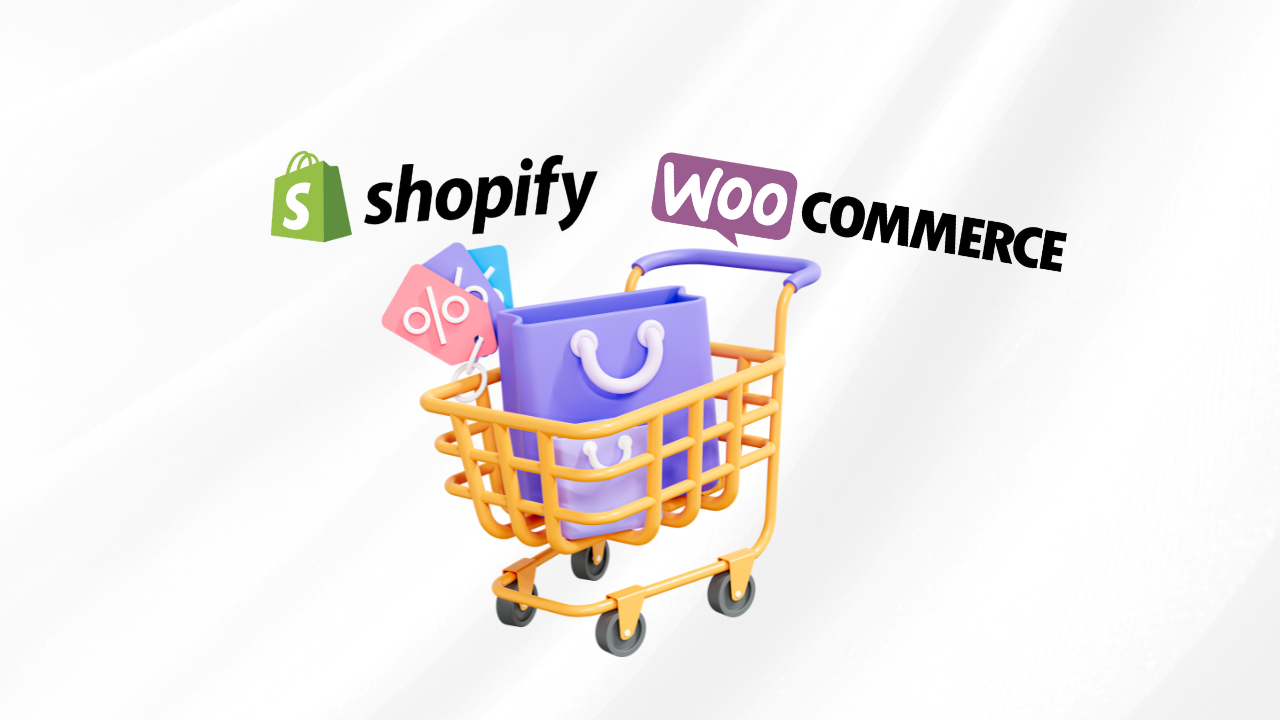Shopify vs WooCommerce – Which one is best in 2025?
The e-commerce world has immensely expanded, and to stay ahead of the aggressive competition, it provides many platforms for growing and operating all online stores. The two major favourite rivals in the market are Shopify and WooCommerce. Each has uncertain features, different pros and cons, and multifunctional platforms. Woocommerce is considered as shopify alternative and Shopify is mostly considered as Woocommerce alternative. This blog is written down to understand the debate on Shopify vs WooCommerce, which is an ideal pick for your online store. Let’s not waste more time and start it.
Shopify and WooCommerce : Quick Overview

SHOPIFY
Shopify is a completely hosted ecommerce platform that offers all the basic tools that you require at start, handle and build a successful online store. It is especially famous for its simplified functionality, modern designs and engaging features. Shopify mainly focuses on safety and security, hosting and software upgrades. These make Shopify a complete package solution for all ecommerce marketers.
WOOCOMMERCE
WooCommerce, on the contrary, is a public-driven plugin specifically designed for WordPress. It easily changes a WordPress website into a completely operational online store. WooCommerce provides innovative customized options and impressive flexibility and various customization choices, making it famous in those people who like to have complete control over their sites.
1. USER-FRIENDLINESS
Shopify
WooCommerce
Shopify is built to be user-friendly, making it easy to use even for those people who have no knowledge of technical skills. Starting a store is very simple, and Shopify deserves a big appreciation because of its drag-and-place builder and instinctive dashboard. Shopify effectively manages all the backend operations so you can concentrate on your store without any hesitation.
WooCommerce needs a little extra technical awareness to start up, and it is a WordPress plugin, so you must have access to a WordPress website and a strong hosting service before onboarding the installation of WooCommerce. No doubt it offers a detailed step-by-step guide, updates, security and managing hosting is solely your take to handle.
2. COST ANALYSIS
Shopify
WooCommerce
Shopify operates on a subscription-based pricing model. The basic plan starts at $29 per month, while the advanced plans can go up to $299 per month. Shopify charges transaction fees if you use payment gateways other than Shopify Payments.
WooCommerce itself is free to download and use, but you need to factor in the costs of hosting, a domain name, and premium plugins or themes. Hosting can cost anywhere from $5 to $25 per month, and additional features may require purchasing paid plugins.
3. CUSTOMIZATION AND DESIGN
Shopify
WooCommerce
Shopify offers a range of professionally designed themes, both free and premium. These themes are mobile-friendly and customizable through the Shopify editor. However, customization is somewhat limited unless you know coding.
WooCommerce gives you access to thousands of WordPress themes, both free and paid. It offers unparalleled customization options, allowing you to tweak every aspect of your store. For those familiar with coding, WooCommerce is the better choice for creating a truly unique design.
4. SCALABILITY AND UNIQUE FEATURES
Shopify
WooCommerce
Shopify’s scalable infrastructure is ideal for businesses planning to grow rapidly. Shopify also comes with built-in features such as inventory management, payment processing, and marketing tools. The Shopify App Store also offers over 6,000 apps to extend your store’s functionality.
WooCommerce relies heavily on plugins for additional features. While this allows for greater flexibility, managing multiple plugins can become cumbersome. WooCommerce can handle scalability, but you need to ensure your hosting plan can accommodate increased traffic.
5. PAYMENT METHODS
Shopify
WooCommerce
Shopify’s scalable infrastructure is ideal for businesses planning to grow rapidly. Shopify also comes with built-in features such as inventory management, payment processing, and marketing tools. The Shopify App Store also offers over 6,000 apps to extend your store’s functionality.
WooCommerce relies heavily on plugins for additional features. While this allows for greater flexibility, managing multiple plugins can become cumbersome. WooCommerce can handle scalability, but you need to ensure your hosting plan can accommodate increased traffic.
6. SEO & MARKETING
Shopify
WooCommerce
Shopify offers built-in SEO features such as customizable title tags and meta descriptions. It also integrates seamlessly with marketing tools like Google Ads and Facebook. However, Shopify’s URL structure is less customizable compared to WooCommerce.
WooCommerce is built on WordPress, which is renowned for its SEO capabilities. You can use plugins like Yoast SEO to optimize your store for search engines. Additionally, WooCommerce provides more control over your website’s marketing strategies.
7. SUPPORT AND COMMUNITY
Shopify
WooCommerce
Shopify provides 24/7 customer support via live chat, email, and phone. It also has an extensive knowledge base and active community forums.
WooCommerce does not offer dedicated support since it is an open-source plugin. However, there is a large community of developers and forums where you can find help. Hosting providers may also offer support for WordPress and WooCommerce issues.
8. PRO'S AND CON'S
Shopify Pros
Shopify Cons
- User-friendly interface
- Reliable hosting included
- Comprehensive customer support
- Great for beginners
- Monthly subscription costs
- Limited customization
- Additional transaction fees for third-party gateways
WooCommerce Pros
WooCommerce Cons
- Highly customizable
- Free to use (excluding hosting and add-ons)
- Extensive SEO capabilities
- No additional transaction fees
- Requires technical knowledge
- Hosting and security are your responsibility
- Can be time-consuming to manage
10. Which One Should Be Your Choice?
The choice between Shopify and WooCommerce largely depends on your needs, budget, and technical expertise.
- Choose Shopify if: You want a simple, hassle-free solution with excellent support and don’t mind paying a monthly fee.
- Choose WooCommerce if: You need complete control over your website and are comfortable managing technical aspects.
Final Thoughts:
Shopify and WooCommerce are both excellent platforms, each catering to different types of users. Shopify’s all-in-one approach is perfect for beginners and growing businesses, while WooCommerce’s flexibility makes it ideal for those seeking customization and control. By carefully assessing your business needs and resources, you can choose the platform that best suits your e-commerce goals.
With the right choice, your e-commerce journey can be smooth, scalable, and profitable, ensuring long-term success.
By completing this form you agree to the Terms of Use & IP and our Privacy Policy
Talha Irshad is the Director and CEO of various ventures as well as GFX SQUARE. He is a content creator by passion. He has a keen interest in content creation and sharing valueable content. He has alot of top-ranked articles and blogposts.
Latest Updates Related To Branding



How to Choose the Best Digital Marketing Agency in Pakistan

Contact info
- L-155, Diaomond City, near Gulshan e Maymar, Karachi, Pakistan
- +92 3399111009
- business@gfxsquare.com
Newsletter
- 2025
- GFX Square - Best Digital Marketing Company.
- All rights reserved.


